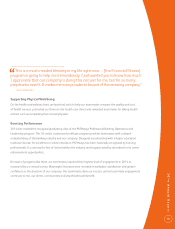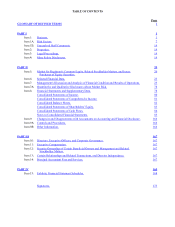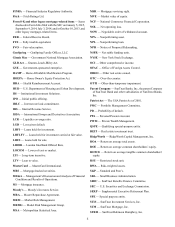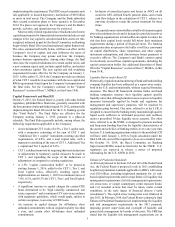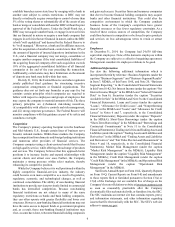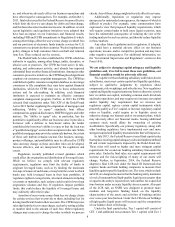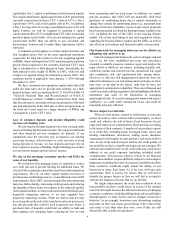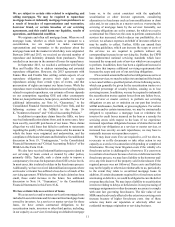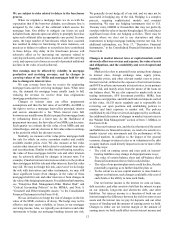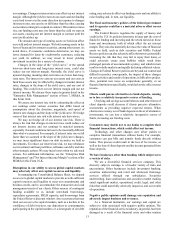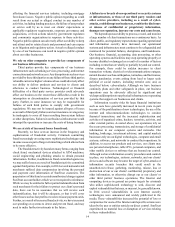SunTrust 2014 Annual Report Download - page 27
Download and view the complete annual report
Please find page 27 of the 2014 SunTrust annual report below. You can navigate through the pages in the report by either clicking on the pages listed below, or by using the keyword search tool below to find specific information within the annual report.4
addition to, and intended to be complementary to, those imposed
by the final LCR rule. The FRB has not yet adopted final rules
regarding single counterparty exposure limits and early
remediation.
Other Regulation
The Federal Reserve and the FDIC have issued substantially
similar risk-based and leverage capital guidelines applicable to
U.S. banking organizations. Additionally, these regulatory
agencies may require that a banking organization maintain
capital above the minimum levels, whether because of its
financial condition or actual or anticipated growth. The Federal
Reserve risk-based guidelines define a tier-based capital
framework. Tier 1 capital includes common shareholders' equity,
trust preferred securities, certain non-controlling interests and
qualifying preferred stock, less goodwill (net of any qualifying
DTL) and other adjustments. Beginning in 2015, a phase out
period will begin for trust preferred securities included in Tier
1, resulting in a complete phase-out of Tier 1 by January 1, 2016.
These trust preferred securities will become includable in Tier 2
capital. Tier 2 capital consists of preferred stock not qualifying
as Tier 1 capital, mandatorily convertible debt, limited amounts
of subordinated debt, other qualifying term debt, the allowance
for credit losses up to a certain amount and a portion of the
unrealized gain on equity securities. The sum of Tier 1 and Tier
2 capital represents the Company's qualifying total capital. Risk-
based capital ratios are calculated by dividing Tier 1 and total
capital by RWAs. Assets and off-balance sheet exposures are
assigned to one of four categories of risk-weights, based
primarily on relative credit risk. Additionally, the Company, and
any bank with significant trading activity, must incorporate a
measure for market risk in their regulatory capital calculations.
The leverage ratio is determined by dividing Tier 1 capital by
adjusted average total assets. The Federal Reserve also requires
the Company to calculate, report, and maintain certain levels of
Tier 1 common equity. Tier 1 common equity is calculated by
taking Tier 1 capital and subtracting certain elements, including
perpetual preferred stock and related surplus, non-controlling
interests in subsidiaries, trust preferred securities and
mandatorily convertible preferred securities. Under the final
Basel III rules, as discussed above, the capital requirements for
bank holding companies and banks will increase substantially.
The federal banking agencies have broad powers with which
to require companies to take prompt corrective action to resolve
problems of insured depository institutions. The extent of these
powers depends upon whether the institutions in question are
“well capitalized,” “adequately capitalized,” “under-
capitalized,” “significantly undercapitalized” or “critically
undercapitalized,” as such terms are defined under regulations
issued by each of the federal banking agencies, including
progressively more restrictive constraints on operations,
management, and capital distributions. Failure to meet the capital
guidelines could also subject a banking institution to capital
raising requirements. An “undercapitalized” bank must develop
a capital restoration plan and its parent holding company must
guarantee that bank's compliance with the plan. The liability of
the parent holding company under any such guarantee is limited
to the lesser of 5.0% of the bank's assets at the time it became
“undercapitalized” or the amount needed to comply with the
plan. The final capital rules described above amended the prompt
corrective action framework to include the new CET 1 measure
and higher minimum capital requirements, effective January 1,
2015, such that the minimum CET 1, Tier 1 risk-based, and total
risk based measures required to be “adequately capitalized” will
be 4.5%, 6.0%, and 8.0%, respectively, “well-capitalized”, will
be at least 2.0% higher in each respective category, and the
minimum standard leverage ratio to be adequately capitalized
and well-capitalized will be 4.0% and 5.0%, respectively.
Furthermore, in the event of the bankruptcy of the parent holding
company, such guarantee would take priority over the parent's
general unsecured creditors. Additionally, FDICIA requires the
various regulatory agencies to prescribe certain non-capital
standards for safety and soundness relating generally to
operations and management, asset quality, and executive
compensation and permits regulatory action against a financial
institution that does not meet such standards.
Regulators also must take into consideration:
(i) concentrations of credit risk; (ii) interest rate risk (when the
interest rate sensitivity of an institution's assets does not match
the sensitivity of its liabilities or its off-balance sheet position);
and (iii) risks from non-traditional activities, as well as an
institution's ability to manage those risks, when determining the
adequacy of an institution's capital. Regulators make this
evaluation as a part of their regular examination of the
institution's safety and soundness. Additionally, regulators may
choose to examine other factors in order to evaluate the safety
and soundness of financial institutions. The Federal Reserve
announced that its approval of certain capital actions, such as
dividend increases and stock repurchase, will be tied to the level
of CET 1, and that bank holding companies must consult with
the Federal Reserve's staff before taking any actions, such as
stock repurchases, capital redemptions, or dividend increases,
which might result in a diminished capital base.
In addition, there are various legal and regulatory limits on
the extent to which the Company's subsidiary bank may pay
dividends or otherwise supply funds to the Company. Federal
and state bank regulatory agencies also have the authority to
prevent a bank or BHC from paying a dividend or engaging in
any other activity that, in the opinion of the agency, would
constitute an unsafe or unsound practice. In the event of the
“liquidation or other resolution” of an insured depository
institution, the FDIA provides that the claims of depositors of
the institution (including the claims of the FDIC as subrogee of
insured depositors) and certain claims for administrative
expenses of the FDIC as a receiver will have priority over other
general unsecured claims against the institution. If an insured
depository institution fails, insured and uninsured depositors,
along with the FDIC, will have priority in payment ahead of
unsecured, nondeposit creditors, including the parent BHC, with
respect to any extensions of credit they have made to such insured
depository institution.
The standard deposit insurance amount provided by the
FDIC is $250,000 per depositor, per insured bank, per ownership
category. It provides this insurance through the DIF, which the
FDIC maintains by assessing depository institutions an
insurance premium. The FDIC assesses deposit insurance
premiums on the basis of a depository institution's average
consolidated net assets using a premium rate that includes a
variety of factors that translate into a complex scorecard.


